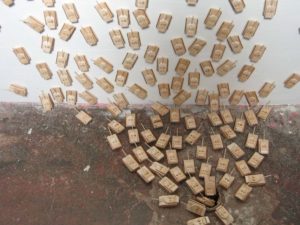A Spoonful of Sugar at the Luggage Store
This piece was published in Artweek, Vol 5, no. 66. It can be cited here as It an be cited here as: Buckner, Clark. “A Spoonful of Sugar at the Luggage Store.” www.clarkbuckner.com. Web. Day, Month, Year article as accessed.

Michael Arcega, “Tanks A Lot”
On the eve of the 2004 presidential election, the war in Iraq and other disastrous policies of the Bush administration inspired a great deal of politically engaged art. Unfortunately much of it remained limited to Bush-bashing and rebellious acts of defiance that did little to diagnose the realities of our political condition. In The Luggage Store’s exhibition, “A Spoonful of Sugar,” Jackie Sumell’s Bald Eagle “Piñata” fell into that category. By the time I saw it, it lay smashed in the center of the gallery spilling candy and fundamentalist religious tracts in both English and Arabic onto the floor. However satisfying it must have been to crush the piñata as a symbol of the American government hijacked by right-wing religious crusaders, the work remained a crude caricature of the U.S. and invited dismissal of left-wing critics of the Bush administration as merely “anti-American,” with little more to offer than someone swinging a bat blindfolded. On the other hand, the doormat that Sumell placed at the entrance to the show (which she curated), which read “War is Not Over,” presented a welcome rebuttal to John Lennon and Yoko Ono’s overly-idealistic 1969 campaign “War is Over – if you want it,” and announced the persistent problem of social-political conflict as the point of departure for the exhibition.
In his contribution to the show, Packard Jennings offered caricatures of the Bush administration that, like much politically engaged art, depended heavily on an assumed message for which the work itself was only an incidental vehicle. One piece, “The Second Labor of Dick Cheney,” presented a nude, revolving sculpture of Cheney fighting a three-headed snake, which was quite hilarious in its juxtaposition of Cheney’s paunch with the heroics of mythology. In an animated video, “Public Discourse,” Packard depicted Bush’s cabinet explaining their beliefs, actions, and intentions with brutal honesty. The piece relied on the cliché of Bush as an idiotic puppet and failed to recognize Bush’s very real power as a speaker and figurehead. Nevertheless the video was laudable in its vivid portrayal of the administration and concise analyses, among other things, of the neo-conservatives exploitation of September 11th for their imperialist agenda, the systematic bankrupting of the federal government, and the close alliance of the two parties (as “muscular liberals” and “compassionate conservatives”) in their common commitment to corporate globalization.
In the video, “Tank,” Mad Lynnerup drove an SUV through the city with the cardboard cutout of a tank mounted on one side of it. A man wearing a pot on his head for a helmet popped out from the sunroof and held a cannon out over the front of the truck. The piece called attention to the militarism of the commonplace epitomized by the SUV, and drew a direct connection between the everyday aesthetics of car-culture, and the ideology of U.S. foreign policy.
Through a series of forty-nine consecutive snapshots printed as a single collage, Julia Page documented a performance in “Desert Shade,” in which she and another woman, wearing matching white jumpsuits, walked into the desert, dug a hole, crawled in it, and covered themselves with a silver reflective blanket. The performance followed instructions from a survivalist manual downloaded from the Internet and revealed the absurd identity between the survivalist’s fearful flight and the blindness of having one’s head in the sand – but it didn’t stand apart from it. Rather Page adopted this fear and blindness as her own and explored it, as part of an on-going study of shelter, by crawling into the hole herself. The women’s pursuit of safety was compelling and, in this light, the work resembled stills from a dystopic science-fiction film.
Page’s video “Best Laid Plans” continued this exploration of the search for safety, by showing a series of non-descript places (the corner of a room, the back of a van, the backyard of a house) that, in succession, were filled by animated overlays of survivalist architecture and gear (first aid kits, canned goods, tanks of gas, cinderblock walls, mounted guns, and antennae). Survivalism and militarism became indistinguishable as each of these private spaces was progressively reconstructed as a fortress. Again Page put herself and her audience in the position of the survivalist by showing the video through a monitor constructed to resemble the lookout of a bunker or tank. Like Stanley Kubrick’s “Dr. Strangelove” the work seemed to ask whether our fear and aggression stem from international crises and the threat of terrorism, or the reverse?
In “Sign Here: Washington St and Kearny” Steve Lambert studied the role of signification in the constitution of reality by painting a San Francisco street scene and leaving out the content of all the signs. In their place, he inserted red arrow stickers typically employed in legal documents that read, “sign here.” The painting explored the role of signs in shaping public space and, through the ambivalence of the expression, “sign here,” examined the role of signification in constituting a sense of identity. In other work, I have seen Lambert facilely presuppose the distinction between ideology and reality, and idealistically moralize about the manipulations of commercial imagery – pointing out that it is “only advertising,” and disavowing the reality of the hold that commercial imagery has on us. But, in his “Sign Here” series, he paints out both commercial and public signs – the parking sign as well as the billboard – and explores signification without ready-made moral distinctions. He doesn’t presume to stand on the safe ground of reality but rather recognizes the role of signification in identification as such. Like a study of Althusser’s theory of interpolation, he presents seeing as reading, and reading as a way in which we both situate ourselves in the world and inscribe ourselves into social life.
And, in “Tanks A Lot,” Michael Arcega constructed a nightmarish installation with a swarm of miniature wooden tanks crawling like Roaches out of a hole in the floor, up the wall, and onto the ceiling. The piece presented a vivid image of the imperialist spread of the military and a Kafkaesque study of authoritarianism. I wanted to crush the tanks like bugs and, in my spite, recognized the love of tyranny that fuels military expansion.
Kristen Lucas installed a thirty-minute radio play, “The Dispatcher: Carrying Green,” that was too long and involved for me to engage properly. And Pam Martin and Linda Ford staged a performance at the opening, which I missed. Dressed as police officers, they made their way through the reception cornering people behind shields like protestors.
No matter who will be president for the next four years (as yet to be determined when this was written), the social and psychological conflicts that inform the current catastrophes still will be with us, and still will shape not only our politics but our culture. “A Spoonful of Sugar,” succeeds insofar as it transcends the all-too-comforting promise of a new president, and addresses these more fundamental concerns.
